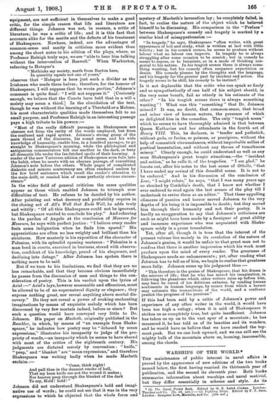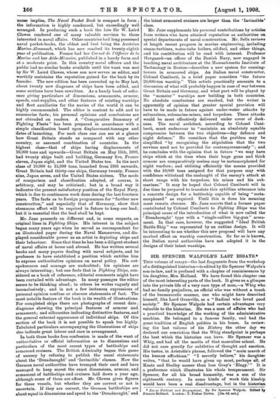WARSHIPS OF THE WORLD.* THE maintenance of public interest in
naval affairs is proved by the appearance of new editions of the two books named below, the first having reached its thirteenth year of publication, and the second its eleventh year. Both books summarise information about warships and naval materiel, but they differ essentially in scheme and style. As its • (1) The Naval Pocket Book. Edited by G. S. Laird Climes. London: Thacker and Co. [7s. dd. net.)—(2) Fighting Ships. Edited by F. T. Jane. London Sampson Lows Marston. and Co. [21s. nat. .1 name implies, The Naval Pocket Book is compact in form ; the information is highly condensed, but exceedingly well arranged. In producing such a book the late Sir W. Laird Clowes rendered one of many valuable services to those interested in naval affairs. Other countries had long possessed naval pocket-books, the oldest and best being the Austrian Marine-Almanach, which has now reached its twenty-eighth year of publication. France had her Carnet de l'Ojficier de la Marine and her Aide-Mmoire, published in a bandy form and at a moderate price. In this country naval officers and the public had no similar books available until the want was met by Sir W. Laird Clowes, whose son now serves as editor, and worthily maintains the reputation gained for the book by its founder. The new edition has been corrected up to May last, about twenty new diagrams of ships have been added, and some sections have been rewritten. As a handy book of refer- ence giving particulars of dimensions, armaments, armour, speeds, coal-supplies, and other features of existing warships and fleet auxiliaries for the navies of the world it can be highly recommended. The editor is content to edit and to summarise facts ; his personal opinions and conclusions are not obtruded on readers. A " Comparative Summary of Fighting Fleets" has been prepared in accordance with a simple classification based upon displacement-tonnages and dates of launching. For each class one can see at a glance how Great Britain stands as compared with any other country, or assumed combination of countries. In the highest class—that of ships having displacements of 16,000 tons and upwards—Great Britain on May 15th, 1908, had twenty ships built and building, Germany five, France eleven, Japan eight, and the United States ten. In the next class of 10,000 to 15,999 tons, launched from 1895 onwards, Great Britain had thirty-one ships, Germany twenty, France nine, Japan seven, and the United States sixteen. The mode of comparison and classification adopted, of course, is arbitrary, and may be criticised ; but in a broad way it indicates the present satisfactory position of the Royal Navy, which is due to continuous work done during the last fourteen years. The facts as to foreign programmes for "further new construction," and especially that of Germany, show that strenuous effort will be required in future to keep our lead; but it is essential that the lead shall be kept.
Mr. Jane proceeds on different and in some respects, on original lines in Fighting Ships. His interest in the subject began many years ago when he served as correspondent for an illustrated paper during the Naval Manoeuvres, and dis- played considerable power as an artist in depicting ships and their behaviour. Since that time he has been a diligent student of naval affairs at home and abroad. He has written several books and many papers dealing with naval subjects, and he professes to have established a position which entitles him to express authoritative opinions on naval policy. His out- spokenness and courage are undoubted ; his opinions are always interesting ; but one feels that in Fighting Ships, con- sidered as a book of reference, editorial comments might have been curtailed with advantage. In many passages the editor seems to be thinking aloud ; in others he writes vaguely and inconclusively ; and in not a few instances expressions of personal opinion confuse or obscure statements of fact. The most notable feature of the book is its wealth of illustrations. For completed ships there are photographs of recent date ; diagrams showing the principal features of armour and armament; and silhouettes indicating distinctive features, and the general external appearance of individual ships. Of this section of the book it is not possible to speak too highly. Tabulated particulars accompanying the illustrations of ships also indicate great labour and care in arrangement.
In both these books free confession is made of the want of authoritative or official information as to dimensions and particulars of the most recent types of battleships and armoured cruisers. The British Admiralty began this game of secrecy by refusing to publish the usual statements about the 'Dreadnought' and 'Invincible' classes. Now the German naval authorities have trumped their card and have managed to keep secret the exact dimensions, armour, and armament of battleships and cruisers laid down a year ago, although some of them are afloat. Mr. Clowes gives figures for these vessels, but whether they are correct or not is uncertain. If they are correct, the German battleships are about equal in dimensions and speed to the 'Dreadnought,' and
the latest armoured cruisers are larger than the `Invincible' class.
Mr. Jane supplements his personal contributions by articles from writers who have attained reputation as authorities on special departments of naval construction. Mr. Sells reviews at length recent progress in marine engineering, ipcluding steam-turbines, water-tube boilers, oil-fuel, and other things, and his contribution will be read with interest. Professor Hovgaard—an officer of the Danish Navy, now engaged in teaching naval architecture at the Massachusetts Institute of Technology in Boston—describes a new system for conning- towers in armoured ships. An Italian naval constructor, Colonel Cuniberti, in a brief paper considers "the future 20,000-ton warship." This article practically amounts to a discussion of what will probably happen in case of war between Great Britain and Germany, and what part will be played by the " monster" warships now building in both countries. No absolute conclusions are reached, but the writer is apparently of opinion that greater special provision will have to be made in future against under-water attacks by submarines, submarine-mines, and torpedoes. These attacks would be most effectively delivered under cover of dark- ness. The naval architect, according to Colonel Cuni- berti, must endeavour to " maintain an absolutely equable compromise between the two objectives—day defence and night defence." He considers that the problem may be simplified " by recognising the stipulation that the two services need not be provided for contemporaneously "; and he concludes with the opinion that in future " we may have ships which at the time when their huge guns and thick armour are comparatively useless may be metamorphosed for night warfare ; and utilising efficiently the means provided with the 10,000 tons assigned for that purpose may with confidence withstand the onslaught of the enemy's attack at short range with his torpedoes, his mines and his sub- marines." It may be hoped that Colonel Cuniberti will in due time be prepared to translate this sybilline utterance into a concrete design for a battleship capable of being "meta- morphosed" as required. Until this is done his meaning must remain obscure. Mr. Jane asserts that a former paper contributed by Colonel Cuniberti to Fighting Ships was the principal cause of the introduction of what is now called the Dreadnought' type with a "single-calibre big-gun" arma- ment. In that case, however, the suggested "Ideal British Battle Ship " was represented by an outline design. It will be interesting to see whether this new proposal will have any marked effect on warship construction. So far as is known, the Italian naval authorities have not adopted it in the designs of their latest warships.



































 Previous page
Previous page